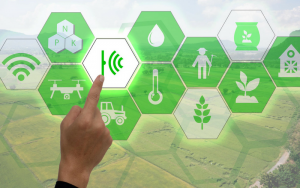Digital Reinvention
Doubling Farmer Income “Digitally”
July 21, 2018 | Written by: Girija
Categorized: Digital Reinvention
Share this post:
What is one economic activity in India that’s larger than any other in terms of size, people or impact?
Of course, it is indeed Agriculture!
Not only agriculture contributes with 17% of India’s GDP, it provides livelihood for 50% of our population and constitutes about 400B US$ of economic value. And while industries ranging from retail to telecom to entertainment are getting reshaped by digital forces (or worse, getting wiped out!), the value chain agriculture has remained rather untouched. Until now.
Despite being among top global producer of Pulses, Rice, Milk, Jute etc., our Agri value chain is widely acknowledged to be among the most broken and inefficient globally. Let me share some statistics – Rice yields in India are 40% of US levels and lower many other emerging nations; worse, the GVA growth per agriculture worker is less than half at 2%. There are three primary issues here –
One, level of farm mechanisation is about 35- 40% in India while most developed countries have over 90% mechanisation. Second, farmer value realisation (What % of final consumer price goes to farmer) is between 20 – 30% versus global benchmark of 50 -60%
And third, food processing is still less than 15% in India compared to global averages of 30 – 40%.
In my view, each of these underlying factors are about to change and if it happens, it could create impact far bigger than the unicorns we can’t seem to stop talking about. A combination of factors is at work –
- Rise of Indian Consumer
- Emergence of AgriTech,
- Data Revolution in Rural India
- Push to Double Farm Income by 2022

RISING INDIAN CONSUMER
Clearly, this is one of the mega trend for 21st century India and a trend that’s likely to continue as our demographic dividend pays off with young and productive workforce until 2050. Emergence of nuclear families, online groceries, acceptability of processed food and coming of age of foodtech – Each of these will play a role in removing the middleman and increasing the share of processed food in our diet. For example, by end of 2016, India already had about 400 food delivery apps and over 100 grocery startups.
While many of those have shut shop since, we do have several winners emerging, some of whom are latest darlings of PE investors – Swiggy, Zomato, BigBasket et al. Govt. has allowed for 100% FDI in the marketing of food products as well as food e-commerce through automatic route. Even within the FMCG space, there is considerable innovation in food, particularly healthy food resulting in emergence of brands like Raw, Epigama, Paperboat etc.
EMERGENCE OF AGRITECH
Agri-tech is clearly the next big thing in digital. As per NASSCOM, Global Agri-Tech investment in 2016 was 3.2B US$ and in same period India got about 320M US$ funding for 50+ start-ups – almost 10% of global figure. And India is among top 5 countries globally in term of AgriTech Deals. There are AgriTech start-ups across the entire farm to fork value chain – Agri Inputs, Remote sensing, Agri advisory, Market linkage, Farming as a service and IoT enabled technologies.
For example, today you can get buy seeds and fertilisers online (Poorti, KisanPoint) rent farm implements (Trinngo, FarmRing), get weather and disease forecasts (The Weather Company), get mobile based agri advisory (m-kisan, RML agtech), Check prices at local and remote Mandis (eNAM) and sell your produce online (eNAM, ConnectFarmer, NinjaCart). All of this is happening and more, albeit the adoption is yet to reach critical mass in most cases.
In terms of remote sensing, the cost of satellite imagery has plummeted and high resolution images of up to 1m by 1m are accessible. This is going to create a whole new set of use cases – for example, you could combine remote sensing with image analytics to identify farm diseases and advise the farmer to take necessary steps. Accurate weather advisory coupled with pest models can provide yield forecasts and early warning signals for diseases.
Even the area of crop insurance will get disrupted through remote sensing as the need for manual inputs like Crop Cutting Experiments will give rise to remote assessment of farm yields.
DATA REVOLUTION in RURAL INDIA
Consider this – 58% of internet users in rural India regularly access video content versus about 70% of urban Indian. Last year, YouTube stated its ambition to double the use base to 800M in next 2 to 3 years – Of this 50% are expected to come from rural India. While currently, the mobile internet penetration is quite small at 18% but it’s growing at over 15% as per an IAMAI report.
Since mobile is the primary vehicle for any digital disruption, this breaking of final barrier to mobile adoption is a wonderful thing for rural economy. The entire agri value chain is now wide open for innovative tech driven business models.
DOUBLING FARM INCOME BY 2022
The average Increase in Agri produce price was only 6.8% between 2011 and 2016. And doubling farmer income by 2022 over 2015 baseline requires an annual growth rate of 10.4% (source – Niti Aayog). Therefore, achieving this vision considerable effort and non-ordinary steps by both central and state Governments.
Fortunately, Govt. is quite active and is working on multiple initiatives to drive farmer income, the most important being the effort to dismantle the current APMC regime and hold of middlemen through policy and technology. Some examples include, easing APMC to allow direct sale by producers to processing industries / bulk buyers, taking fruits and vegetables out of APMC act, allowing private Mandis and easing trading licensing norms.
However, the real game changer in this would be the launch of eNAM (e-National Agriculture Mandi) which will enable 7000+ Mandis to be connected and create a common, uniform and digital marketplace for agri produce. Simarlarly, eRAKAM is being envisaged as the platform for auction of agri produce.
With these structural shifts in policy, emergence of right technology, entry of risk taking entrepreneurs and a facilitative govt., the future looks bright for Indian farmer.

Partner and Executive Director
Just launched – IBM Security Command Center in India
IBM Security Command Center launch in Bengaluru, India
Insurance Company Brings Predictability into Sales Processes with AI
Generally speaking, sales drives everything else in the business – so, it's a no-brainer that the ability to accurately predict sales is very important for any business. It helps companies better predict and plan for demand throughout the year and enables executives to make wiser business decisions.
Never miss an incident with an application-centric AIOps platform
Applications are bound to face occasional outages and performance issues, making the job of IT Ops all the more critical. Here is where AIOps simplifies the resolution of issues, even proactively, before it leads to a loss in revenue or customers.


